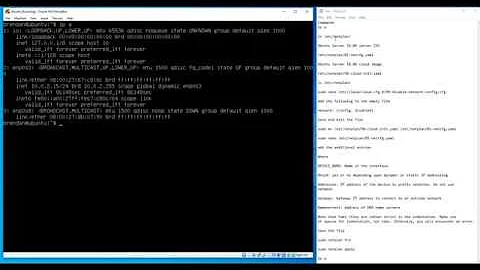Setting 2 IPs on Ubuntu 12.04 with two network adaptor card
The problem is that you can't have two 'default' gateways by default. How would The kernel know which interface to use if it's being told to use two different interfaces.
A quick search online found a recent post showing how to do it by creating a second routing table.
Without knowing what limitations you may be working with, why use two separate interfaces? From the looks of it, these two IPS are actually part of the same block. Why not just use an alias on eth0 for the second IP? If it's for bandwidth reasons you should consider setting up link aggregation(LACP, set up with the bonding kernel module) so both addresses can take advantage of the extra (virtual) nic. Assuming each virtual nic is connected to a separate real NIC (going to the same switch) you would also get redundancy for both IPs should one of the cables get pulled or a card goes bad on the VMware host.
Related videos on Youtube
Comments
-
 r004 almost 2 years
r004 almost 2 yearsThere is a VPS runing ubuntu 12.04.3 server on vmware esxi 5.
It has 2 valid static IPs and two network cards eth0 and eth1. but only one of the assigned ips is pingable from outside. (both ips ang gateway is pigable from inside).
it seems that I receive packets on dead IP, but don't reply them. ifconfig will returns:eth0 Link encap:Ethernet HWaddr 00:50:56:03:43:2b inet addr:91.121.247.155 Bcast:91.121.247.155 Mask:255.255.255.255 inet6 addr: fe80::250:56ff:fe03:432b/64 Scope:Link UP BROADCAST RUNNING MULTICAST MTU:1500 Metric:1 RX packets:179 errors:0 dropped:0 overruns:0 frame:0 TX packets:58 errors:0 dropped:0 overruns:0 carrier:0 collisions:0 txqueuelen:1000 RX bytes:20976 (20.9 KB) TX bytes:7246 (7.2 KB) eth1 Link encap:Ethernet HWaddr 00:50:56:05:11:46 inet addr:91.121.247.148 Bcast:91.121.247.148 Mask:255.255.255.255 inet6 addr: fe80::250:56ff:fe05:1146/64 Scope:Link UP BROADCAST RUNNING MULTICAST MTU:1500 Metric:1 RX packets:174 errors:0 dropped:0 overruns:0 frame:0 TX packets:66 errors:0 dropped:0 overruns:0 carrier:0 collisions:0 txqueuelen:1000 RX bytes:20181 (20.1 KB) TX bytes:8317 (8.3 KB) lo Link encap:Local Loopback inet addr:127.0.0.1 Mask:255.0.0.0 inet6 addr: ::1/128 Scope:Host UP LOOPBACK RUNNING MTU:65536 Metric:1 RX packets:68 errors:0 dropped:0 overruns:0 frame:0 TX packets:68 errors:0 dropped:0 overruns:0 carrier:0 collisions:0 txqueuelen:0 RX bytes:5884 (5.8 KB) TX bytes:5884 (5.8 KB)and ip route:
default via 188.165.247.254 dev eth1 188.165.247.254 dev eth1 scope link 188.165.247.254 dev eth0 scope linkalso ip nei :
fe80::12bd:18ff:fee4:5040 dev eth0 lladdr 10:bd:18:e4:50:40 router REACHABLE fe80::ee30:91ff:fee0:dfc0 dev eth0 lladdr ec:30:91:e0:df:c0 router REACHABLE fe80::12bd:18ff:fee4:5040 dev eth1 lladdr 10:bd:18:e4:50:40 router REACHABLE fe80::ee30:91ff:fee0:dfc0 dev eth1 lladdr ec:30:91:e0:df:c0 router REACHABLEbut arp -a returns NO OUTPUT at all.
this is my /etc/network/interfaces
# This file describes the network interfaces available on your system # and how to activate them. For more information, see interfaces(5). # The loopback network interface auto lo iface lo inet loopback auto eth0 iface eth0 inet static address 91.121.247.155 netmask 255.255.255.255 broadcast 91.121.247.155 post-up route add 188.165.247.254 dev eth0 post-up route add default gw 188.165.247.254 post-down route del 188.165.247.254 dev eth0 post-down route del default gw 188.165.247.254 auto eth1 iface eth1 inet static address 91.121.247.148 netmask 255.255.255.255 broadcast 91.121.247.148 post-up route add 188.165.247.254 dev eth1 post-up route add default gw 188.165.247.254 post-down route del 188.165.247.254 dev eth1 post-down route del default gw 188.165.247.254 dns-nameservers 213.186.33.99the problem is 91.121.247.155 is not pingable from outside. and i don't know why.
-
 Admin over 10 yearsI'm surprised any of them work with your configuration. Your default gateway isn't in your subnet (with a netmask of 255.255.255.255).
Admin over 10 yearsI'm surprised any of them work with your configuration. Your default gateway isn't in your subnet (with a netmask of 255.255.255.255). -
Mike over 10 yearsWhy not setup an ip alias and just use a single device? Is there a reason for 2?
-
-
 r004 over 10 yearsyou answer was illuminating; I guess I should go with IP aliasing and create eth0:0.
r004 over 10 yearsyou answer was illuminating; I guess I should go with IP aliasing and create eth0:0. -
 r004 over 10 yearsyou answer was illuminating; i would go with IP aliasing and I do eth0:0. Now there is a couple of questions. first what should i do with the eth1; should I just leave it be. the second Q? is how should i write the directives for eth0:0.
r004 over 10 yearsyou answer was illuminating; i would go with IP aliasing and I do eth0:0. Now there is a couple of questions. first what should i do with the eth1; should I just leave it be. the second Q? is how should i write the directives for eth0:0.post-up /sbin/ifconfig eth0:0 91.121.247.148 netmask 255.255.255.255 broadcast 91.121.247.148 post-down /sbin/ifconfig eth0:0 downis it right? -
 Admin over 10 yearsYou'll want to search elsewhere for that unfortunately. I spend my time in the RHEL/CentOS world. This howto looks like it would work. As for eth1, if it is connected to the same switch (I would imagine it is if it's vmware); I'd just shut it down for now. If you want to use bonding later you can but if these two virtual interfaces are connected to the same network under VMware, there's not much point in using it unless you need more throughput (and the VMware host actually has a faster uplink like 10Gbit).
Admin over 10 yearsYou'll want to search elsewhere for that unfortunately. I spend my time in the RHEL/CentOS world. This howto looks like it would work. As for eth1, if it is connected to the same switch (I would imagine it is if it's vmware); I'd just shut it down for now. If you want to use bonding later you can but if these two virtual interfaces are connected to the same network under VMware, there's not much point in using it unless you need more throughput (and the VMware host actually has a faster uplink like 10Gbit). -
 r004 over 10 yearsHow to IP Alias in with this condition; I did the above and I got nothing. still 148 is not pingable from the outside.
r004 over 10 yearsHow to IP Alias in with this condition; I did the above and I got nothing. still 148 is not pingable from the outside.




